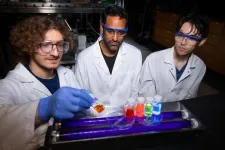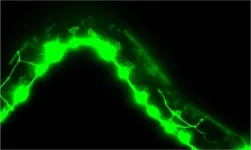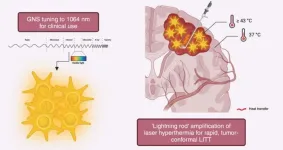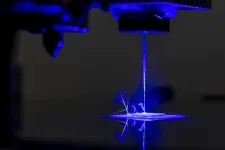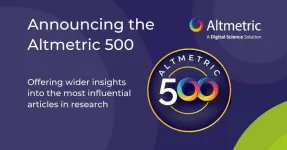(Press-News.org) AMES, Iowa – A Google Cloud video takes you inside a company data center in
southwest Iowa’s Council Bluffs.
There you are, in the middle of a long, industrial corridor. You slowly move past rack after rack after rack of the computer servers that are, Google says, “helping to keep the internet humming 24/7.”
Part of that hum is the power that keeps those data centers up and running.
“Think about when you use your computer,” said Matthew Panthani, an associate professor of chemical and biological engineering at Iowa State University. “It gets hot, right? When the processor performs calculations, it’s using energy. That’s producing heat, which is wasted energy.”
And now, with artificial intelligence tools available to everyone, “there’s a huge spike of energy consumption in the U.S.,” Panthani said. “How can we solve this problem?”
Photons on the job
Panthani is right about spiking energy consumption.
Data centers could use up to 9% of U.S. electricity generation by 2030 – more than double current consumption, according to a study released in May by EPRI, an independent, non-profit energy research and development organization.
The study says the move to artificial intelligence tools is one reason for the spike. Artificial intelligence searches require about ten times more electricity than a traditional internet search. And AI-generated photos, videos and music require even more power.
Panthani’s approach to a solution isn’t a new idea, but it’s been a challenging one: “Use integrated photonics. Let’s use light to transmit data on chips instead of electricity.”
“Fiber optics has already solved this on a global scale,” he said. “It’s the same concept of moving data with light. It’s efficient and fast. But it hasn’t happened with chips yet.”
That’s because there’s a materials problem, Panthani said. The material of choice for semiconductors is silicon, which doesn’t emit light.
Arranging the atoms just so
Panthani’s lab has been working on new materials for integrated photonic circuits since 2017. The lab’s current focus is to develop atom-thin sheets of a silicon-germanium alloy. Those sheets can be stacked in layers separated by alkali metal ions such as lithium or salts, creating layered semiconductors.
A new, three-year, $552,000 grant from the National Science Foundation will support Panthani’s latest work to develop the semiconductors. Three doctoral students – Andrew Tan, Abhishek Chaudhari and Maharram Jabrayilov – will contribute to the effort. The grant will also bring high school teachers into the lab during the summer months, helping them improve their teaching by learning more about scientific research.
In addition to synthesizing the semiconductors “with precise control over the arrangement of atoms in the material,” a project summary says the researchers will study how structure and chemistry influences the semiconductors’ optical and electronic properties and they’ll determine their thermal and environmental stability. All of that would advance basic knowledge in materials chemistry, nanotechnology and semiconductors.
Basically, Panthani said, the semiconductors would emit light “and we want to understand how they could emit light better.”
Achieving that could have real-world applications and implications.
“Integrated photonic circuits have the potential to result in computers and mobile phones that use much less electricity and operate faster,” the summary says.
And maybe one day it won’t take nearly as much power and heat to keep data centers around Iowa – and the world – humming along 24/7.
– 30 –
END
Engineers developing atom-thick material for efficient, ultrafast, light-based electronics
2024-06-24
ELSE PRESS RELEASES FROM THIS DATE:
Study reveals same genes that can drive cancer also guide neural-circuit growth
2024-06-24
LAWRENCE — Many people are familiar with oncogenes — genes long known to be involved in cancers in humans, such as the gene “Src.”
What’s less widely understood is that oncogenes didn’t evolve just to cause cancer in species, but rather to control events of normal growth and differentiation.
“As an organism grows from a single fertilized egg to form all the different tissue types, these oncogenes, including Src, evolved to control these normal events,” said Erik Lundquist, professor of molecular ...
Leveraging gold nanostars for precision laser interstitial thermal therapy
2024-06-24
“Gold nanostars amplify brain-tumor selective laser interstitial thermal therapy.”
BUFFALO, NY- June 24, 2024 – A new editorial paper was published in Oncotarget's Volume 15 on June 14, 2024, entitled, “Leveraging gold nanostars for precision laser interstitial thermal therapy.”
In this new editorial, researchers Aden P. Haskell-Mendoza, Ethan S. Srinivasan, Tuan Vo-Dinh and Peter E. Fecci from Duke University discuss laser interstitial thermal therapy (LITT). Over the past decade, LITT has become an important tool for the neurosurgical treatment of a variety of intracranial pathologies, including focal epilepsies, vascular malformations, and ...
Biodiversity loss from 2010 oil spill worse than predicted
2024-06-24
A new peer-reviewed study from researchers at The University of Texas at Arlington; the University of Nevada, Reno; Mokwon University in Daejeon, Korea; and Texas A&M University at Corpus Christi shows the Deepwater Horizon (DWH) oil spill of 2010 affected wildlife and their habitat much more than previously understood.
“Overall, we found the area of deep-sea floor affected by the DWH spill was significantly larger than previously thought,” said Masoud Rostami, an author of the study and assistant ...
New model shows more realistic picture of intimate partner violence
2024-06-24
ITHACA, N.Y. – Intimate partner violence is notoriously underreported and correctly diagnosed at hospitals only around a quarter of the time, but a new method provides a more realistic picture of who is most affected, even when cases go unrecorded.
PURPLE (Positive Unlabeled Relative PrevaLence Estimator), an algorithm developed by researchers at Cornell University, estimates how often underreported health conditions occur in different demographic groups. Using hospital data, the researchers showed that PURPLE can better quantify which groups of women are most likely to experience intimate partner violence compared with methods that ...
Damon Runyon announces inaugural class of SPARK Scholars
2024-06-24
The Damon Runyon Cancer Research Foundation has named the first cohort of the Damon Runyon Scholars Program for Advancing Research and Knowledge (SPARK), a one-year intensive cancer research internship program for post-baccalaureate students who come from varied backgrounds . The goal of the program is to provide young trainees who have the potential to become leaders in cancer research with rigorous scientific training and a network of mentors and peers to support their next steps into graduate school and beyond.
SPARK Scholars will conduct ...
No assembly required
2024-06-24
University of Missouri researchers have developed a way to create complex devices with multiple materials — including plastics, metals and semiconductors – all with a single machine.
The research, which was recently published in Nature Communications, outlines a novel 3D printing and laser process to manufacture multi-material, multi-layered sensors, circuit boards and even textiles with electronic components.
It’s called the Freeform Multi-material Assembly Process, and it promises to revolutionize ...
Circulating microRNAs likely as effective as A1C for predicting type 2 diabetes in youth, according to OU study
2024-06-24
Type 2 diabetes in young people ages 10 to19 has more than doubled in the past 20 years, yet it remains difficult for physicians to predict who will be diagnosed and who will improve with treatment. A newly published study from the University of Oklahoma shows that measuring the circulating abundance of microRNAs – which affect insulin-producing beta cells in the pancreas – is likely as effective as measuring the level of sugar in the blood for determining how a young person with the condition will fare.
Jeanie Tryggestad, M.D., an associate professor of pediatrics in the OU College of Medicine, led the study, which is published in The Journal of Clinical ...
UMass Amherst scientists to help launch the future of RNA research and biomedicine
2024-06-24
AMHERST, Mass. – Craig Martin, professor of chemistry, and Sarah Perry, associate professor of chemical engineering, both at the University of Massachusetts Amherst, recently received support from the National Institutes of Health (NIH) to develop a novel approach toward efficiently, reliably and cost effectively synthesizing novel strands of specialty “long RNA.” Future genetic research into everything from basic cell biology to advanced therapeutics depends in part on having just the sort of complex, modified RNA that Martin and Perry will be working to make widely available.
RNA is a molecule ...
Myths about intermittent fasting, debunked
2024-06-24
In a new article, researchers at the University of Illinois Chicago debunk four common myths about the safety of intermittent fasting.
Intermittent fasting has become an increasingly popular way to lose weight without counting calories. And a large body of research has shown it’s safe. Still, several myths about fasting have gained traction among clinicians, journalists and the general public: that fasting can lead to a poor diet or loss of lean muscle mass, cause eating disorders, or decrease sex hormones.
In a new commentary in Nature Reviews Endocrinology, UIC researchers debunk each of these. They base their ...
Altmetric 500 data offers wider insight into research’s most influential articles
2024-06-24
Digital Science, a technology company serving stakeholders across the research ecosystem, today announces an exciting new tranche of data that throws light on how and why research cuts through to society at large – in the shape of the Altmetric 500.
A decade on from the first Altmetric 100 reports, which listed the most influential academic articles in a given year, a leading provider of alternative metrics for published research is now releasing an upgraded overview of research engagement: the Altmetric ...
